V. R. Parton
| V. R. Parton | |
|---|---|
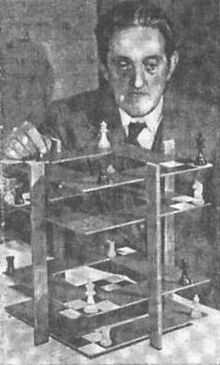 V. R. Parton demonstrating 3D chess to a reporter for The Birmingham Post, 9 September 1957 | |
| Born |
Vernon Rylands Parton 2 October 1897 Cannock, Staffordshire, England |
| Died |
31 December 1974 (aged 77) Liverpool, England |
| Nationality | English |
| Occupation | Teacher |
| Known for |
Alice Chess Chess variant invention |
Vernon Rylands Parton (2 October 1897 – 31 December 1974) was an English chess enthusiast and prolific chess variant inventor, his most renowned variant being Alice Chess.[1][2] Many of Parton's variants were inspired by the fictional characters and stories in the works of Lewis Carroll. Parton's formal education background, like Lewis Carroll's, was in mathematics.[3] Parton's interests were wide and he was a great believer in Esperanto.
Parton's early education stemmed from his father's schools, where he also assisted. Parton's father was headmaster of Cannock Grammar School as well as principal and proprietor of a small international boarding school for children. After completing mathematics at Chester Teaching College, Parton returned to his father's school to give private instruction to older children in Latin, French, German, English, shorthand, typing, bookkeeping, and mathematics. In the 1920s he was left in charge of the school while his father returned to teach in state schools. Ill health cut short Parton's teaching career.
In 1960 Parton moved from Cannock to Liverpool, into a terraced house near Penny Lane, and published a series of nine monographs from 1961 to 1974 (also 1975 posthumously) detailing his inventions. He died from emphysema at age 77 in Liverpool on 31 December 1974. The same year, variant inventor Philip M. Cohen created the variant Parton Chess in his honour.
| “ | I have distinct memories of sitting on his knee and listening to these [Lewis Carroll] stories, and not a book in sight. I always knew him as a gentle and kindly person, and rarely saw one of his dark moods. He seemed to relate best to children. I saw Vern often until about 1950, frequently accompanying him to his favorite location, the town library, or to the tobacconist, he having become a smoker. He seemed very reluctant to go out on his own. He had a favorite uncle, who was blind, and Vern was content to escort him around. Vern never wanted to benefit financially from his work, but asked only for a contribution to charities for the blind. |
” |
| —Peter Parton (nephew)[3] | ||
Some chess variant inventions
Cubic Chess
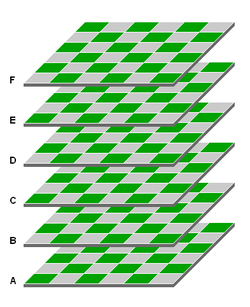
In this 6×6×6 3D variant by Parton, boards are denoted A (bottom level) through F (top level). Each side has six pieces: king (K), queen (Q), bishop (B), unicorn (U), knight (N), and rook (R); and twelve pawns.[4]
Game rules
Pieces move the same as in Raumschach, except that pawns move and capture one step forward (either orthogonally, diagonally, or triagonally), but not directly upward or downward. As in chess and Raumschach, the objective is checkmate.
- White's starting setup: KAa1, QAb1, BAc1, UAd1, NAe1, RAf1; pawns on Aa2–f2 and Ba1–f1
- Black's starting setup: KAf6, QAe6, BAd6, UAc6, NAb6, RAa6; pawns on Aa5–f5 and Ba6–f6
Variation
Parton made a variation of Cubic Chess for the same gameboard: In Compulsion Cubic Chess, capture is compulsory, there are no checks, and the object is capture of the opposing king.
Alice Chess
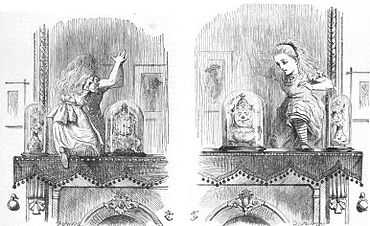
Parton's most famous chess variant, played on two adjacent chessboards. A piece that completes its move on one board automatically "vanishes strangely off its board to appear suddenly on the other board, magically out of thin air!"[5]
Just as Alice encounters strange situations by passing through that looking-glass from reality to its reflection, so for Alician Chess a strange game is created by playing it on two separate boards! One board being as a looking-glass to the other, the resulting play is a game which has a character as fantastic perhaps as Alice's own game in Through the Looking-Glass. What a great loss it has been that Lewis Carroll never left his stamp on some idea for Chess! Whether he would approve of my using Alice's own name of the present game is an unsolvable problem.—V. R. Parton, Curiouser and Curiouser (1961)
From D. B. Pritchard's Popular Chess Variants (2000):[2]
This wonderful game, appropriately named after Lewis Carroll's eponymous heroine, was the inspiration of Vernon Parton. If you pass over every other game in this book, don't miss this one. Still, alas, little known, Alice Chess, now almost a half-century old, continues to attract converts. The body of Alice players grows steadily.
Mad Threeparty Chess
| a | b | c | d | e | f | g | h | i | j | |||
| 10 | 10 | |||||||||||
| 9 | 9 | |||||||||||
| 8 | 8 | |||||||||||
| 7 | 7 | |||||||||||
| 6 | 6 | |||||||||||
| 5 | 5 | |||||||||||
| 4 | 4 | |||||||||||
| 3 | 3 | |||||||||||
| 2 | 2 | |||||||||||
| 1 | 1 | |||||||||||
| a | b | c | d | e | f | g | h | i | j |
This variant is for three[lower-alpha 1] players on a 10×10 board. Each player has a standard set of pieces in his own colour, including an extra king,[lower-alpha 2] but no pawns.
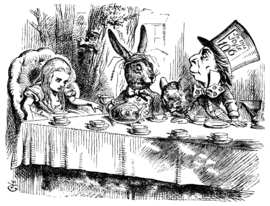
Game rules
The board starts empty. Players take turns, in clockwise rotation around the board, placing one of their pieces on any vacant square. Kings are placed last, but must not be placed in check.
The two kings of each player are marked differently. (For example, of a player's two kings, one might be marked with a star.) Each player attacks the marked king of the opponent to his left, and the unmarked king of the opponent to his right. It is not permitted to check the opponents' other kings.
The first player to checkmate a king wins the game.
Tweedle Chess
| a | b | c | d | e | f | g | h | i | j | |||
| 10 | 10 | |||||||||||
| 9 | 9 | |||||||||||
| 8 | 8 | |||||||||||
| 7 | 7 | |||||||||||
| 6 | 6 | |||||||||||
| 5 | 5 | |||||||||||
| 4 | 4 | |||||||||||
| 3 | 3 | |||||||||||
| 2 | 2 | |||||||||||
| 1 | 1 | |||||||||||
| a | b | c | d | e | f | g | h | i | j |
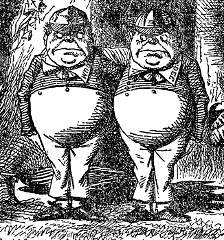
Also known as Twin Orthodox Chess, each player has two kings[lower-alpha 3] and two queens on a 10×10 board. A player wins by checkmating either one of the opposing kings.[lower-alpha 4]
Game rules
The normal chess rules apply, except that kings and rooks can only castle "short" (i.e. with kings shifting two squares toward the nearest corner), and pawns can move one or two steps at any stage.
Comments
"While his pair of Queens will provide the player's main hopes for victory, his twin monarchs King Tweedledee and King Tweedledum jointly provide his sequence of headaches!" (Parton 1961:14) Parton makes note that the only way a player can escape mate from a fork on his two kings is by capturing the checking piece.[lower-alpha 5]
Boyer remarked that the variant yields "magnificent games" because there are two directions of attack and two points to defend.[6]
March Hare Chess
| a | b | c | d | e | f | g | h | ||
| 8 |  | 8 | |||||||
| 7 | 7 | ||||||||
| 6 | 6 | ||||||||
| 5 | 5 | ||||||||
| 4 | 4 | ||||||||
| 3 | 3 | ||||||||
| 2 | 2 | ||||||||
| 1 | 1 | ||||||||
| a | b | c | d | e | f | g | h | ||
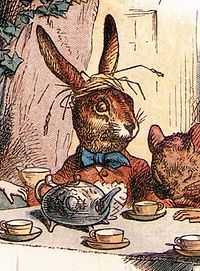
Game rules
For each turn, a player makes two moves: he first moves one of his own pieces, then one of his opponent's men.
- If a player moves one of his pawns, then he may move any enemy piece, "including even the enemy king!" (Parton 1961:24)
- If a player moves his queen, rook, bishop, or knight, then he must move an enemy pawn.
- If a player moves his king, then he may move any enemy piece except the enemy king.
When a player is in check, he must get out of check immediately on his turn by moving one of his own men. (If he cannot legally do so, he loses the game.)
Cheshire Cat Chess
| a | b | c | d | e | f | g | h | i | j | |||
| 10 | 10 | |||||||||||
| 9 | 9 | |||||||||||
| 8 | 8 | |||||||||||
| 7 | 7 | |||||||||||
| 6 | 6 | |||||||||||
| 5 | 5 | |||||||||||
| 4 | 4 | |||||||||||
| 3 | 3 | |||||||||||
| 2 | 2 | |||||||||||
| 1 | 1 | |||||||||||
| a | b | c | d | e | f | g | h | i | j |

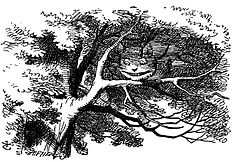
Game rules
In this variant, all normal chess rules apply, except: "Whenever a piece moves from its square, then that particular square must at once completely disappear out of the chessboard!"[lower-alpha 7]
Parton suggests using checker pieces to mark "disappeared" squares. Once vanished, a square may not be occupied again; however, pieces may move through disappeared square(s), including giving check through them.
Since castling is impossible in Cheshire Cat Chess (pieces which normally clear a path for castling cause needed squares to "disappear"), Parton permits the kings to be moved like queens once per game, on their first move.
Variation
The game can also be played using a regular 8×8 board and set, but Parton suggests the 10×10 board with two extra rooks in the corners as "best".[7]
Co-Regal Chess
| a | b | c | d | e | f | g | h | ||
| 8 |  | 8 | |||||||
| 7 | 7 | ||||||||
| 6 | 6 | ||||||||
| 5 | 5 | ||||||||
| 4 | 4 | ||||||||
| 3 | 3 | ||||||||
| 2 | 2 | ||||||||
| 1 | 1 | ||||||||
| a | b | c | d | e | f | g | h | ||
In this variant, the queens are subject to check and checkmate the same as kings.[lower-alpha 8][lower-alpha 9]
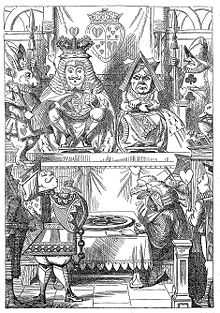
Game rules
Checkmate of the opponent's king or queen wins the game. The queen moves and captures as a normal queen, but may not put itself in check. The queen may pass over attacked squares.
Amplified rules by NOST[lower-alpha 10][8]
A queen, the result of a pawn promotion, is royal. A queen may check a king from a distance, but may not check a queen. Both kings and queens may castle long or short.
Comments
"It will be seen that difficulties for a 'checkmate' of the hostile Queen must chiefly arise from her great mobility which enables her to escape to safety with some degree of ease, in contrast with the King's poor slow power to move out of grave dangers. Victory in Co-regal will be in general achieved by checkmate of the enemy King. [...] A player must acquire two new habits at least. He must crush all his desires to make some brilliant Queen sacrifice. When he attacks the hostile co-regal Queen, he is obliged to give the polite word 'check' as warning!" (Parton 1970, Part I:2)
Sample game
Walter Whiteman vs. Rib Orrell: 1. e4 Nf6 2. Nc3 e5 3. Nf3 Bc5 4. Bc4 Ng4 5. 0-0 Nxf2+ 6. Rxf2 Bxf2+ 7. Kxf2 0-0 8. d3 d6 9. Ng5 Be6 10. Bxe6 fxe6+ 11. Ke1 h6 12. Nxe6+ Qh4+ 13. g3?? Qxh2 0–1 "Black threatens 14...Qg/h1 mate since a K move is illegal as it exposes the Q to check. If 14.Qg4 (only legal move for Q) Rf2 15.Ne2 (forced: Qxg7 is not mate—it's illegal!) Rxe2+ and mate in three." (Pritchard 1994:72)
Dodo Chess (and Racing Kings)
| a | b | c | d | e | f | g | h | ||
| 8 |  | 8 | |||||||
| 7 | 7 | ||||||||
| 6 | 6 | ||||||||
| 5 | 5 | ||||||||
| 4 | 4 | ||||||||
| 3 | 3 | ||||||||
| 2 | 2 | ||||||||
| 1 | 1 | ||||||||
| a | b | c | d | e | f | g | h | ||
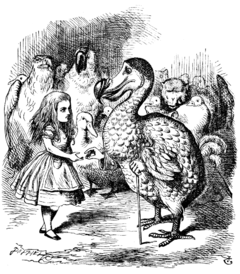
Played on a regular chessboard, this variant is a simple race game: the first player to reach a square on the last rank with his king is the winner.[lower-alpha 11][lower-alpha 12]
Game rules[lower-alpha 13]
Checking is not permitted, neither is exposing one's own king to check. Captures are allowed, however, as in normal chess.
"By way of compensating for the first move (always an advantage in a race game) if White gets there first but Black follows on the next move the game is a draw." (Pritchard 2000:14)
| a | b | c | d | e | f | g | h | ||
| 8 |  | 8 | |||||||
| 7 | 7 | ||||||||
| 6 | 6 | ||||||||
| 5 | 5 | ||||||||
| 4 | 4 | ||||||||
| 3 | 3 | ||||||||
| 2 | 2 | ||||||||
| 1 | 1 | ||||||||
| a | b | c | d | e | f | g | h | ||
Variation
This game, Racing Kings, was the original Dodo Chess before being renamed.[9] The rules are the same as Dodo Chess.
Sample game
R. Betza vs. J. Leitel:[9][10] 1. Bd4 Be4 2. Kh3 Ka3 3. Nxc1 Rxc1 4. Be2? Nb3 5. Bh8? Ka4 6. Kg4 Ka5 7. Qh6 Rc6 8. Qe3 Rxe2 9. Qxe4! Qxh8? 10. Qxc6 Qc3 11. Qh6 Rxe1 12. Rxe1 Qxe1 13. Kf5 Qe7 14. Qe6 Qb7 15. Kg6 Nc5 16. Qf7 Ka6 17. Kh7 Ka7 18. Rg8 (18.Kg8 only draws) 1–0
Parton suggests also that play can be extended to a "double course", where a player wins by being first to go to the eighth rank and then return to the first.
Kinglet Chess
| a | b | c | d | e | f | g | h | ||
| 8 |  | 8 | |||||||
| 7 | 7 | ||||||||
| 6 | 6 | ||||||||
| 5 | 5 | ||||||||
| 4 | 4 | ||||||||
| 3 | 3 | ||||||||
| 2 | 2 | ||||||||
| 1 | 1 | ||||||||
| a | b | c | d | e | f | g | h | ||
Also known as Imperial Fiddlesticks, there is no checking or checkmate in Kinglet Chess – kings are treated like any normal piece.[lower-alpha 16] The winner is the first player to capture all the opponent's kinglets (i.e. pawns or Fiddlesticks).
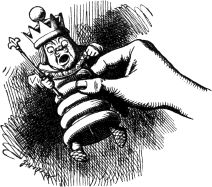
Additional rules
When reaching the last rank, a kinglet promotes to a king. If a player is forced to promote his last kinglet, he is then without any kinglets so automatically loses. All pieces including kings are subject to capture. Stalemate is a draw.
Comments
"The idea contains some interesting problems in tactics. The balance between rushing to capture Fiddlesticks [pawns] quickly and fear of becoming defenceless thereby, (loss of major pieces) seems to be subtle and delicate." (Parton 1961:4)
Variations
Parton suggests two "less subtle" variations in Curiouser and Curiouser, one based on Progressive chess where players make an increasing number of moves per turn, and the other based on Marseillais chess where players move two pieces per turn, at least one of which must be a kinglet (or, the same kinglet may be moved twice).[11]
Looking-Glass Chess
| ||||||||||||||||||||||||||||||||||||||||||||||||||||||||||||||||||||||||||||||||||||||||||||||||||||||||||||||||||||||||||||||||||||
| Looking-Glass Chess comprises two separate but interdependent games. Here White's first move was 1.Nf3/A and the reflected move 1.Nc3/B, and Black's response was 1...d5/B and the reflected move 1...e5/A. | ||||||||||||||||||||||||||||||||||||||||||||||||||||||||||||||||||||||||||||||||||||||||||||||||||||||||||||||||||||||||||||||||||||
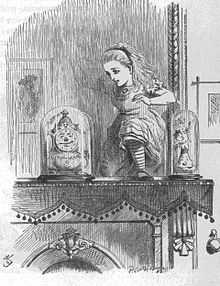
Two separate games ensue in this Parton creation. A player may make any normal move on either board, and then must make the 'looking-glass' (reflected) move on the other board to complete his turn.[lower-alpha 17]
Game rules
To illustrate, if White opens with 1.Nf3 on board A, then he must play 1.Nc3 on board B to complete his turn (see diagram). If a reflected move would put the player in check, then the first move may not be made.
The move of a king or queen must be mirrored on the other board, even if this means moving the king several squares. (For example, in the diagram if White captures 2.Nxe5/A Nxd5/B and Black recaptures 2...Qxd5/B, then Black's reflected move is: 2...Kxe5/A.)
Castling is normal, but then the reflected move must be executed to 'castle' the queen. (E.g. if White castles kingside, then reflected queenside castling results in the queen on b1 and the rook on c1.)
Gryphon Chess
| a | b | c | d | e | f | g | h | ||
| 8 |  | 8 | |||||||
| 7 | 7 | ||||||||
| 6 | 6 | ||||||||
| 5 | 5 | ||||||||
| 4 | 4 | ||||||||
| 3 | 3 | ||||||||
| 2 | 2 | ||||||||
| 1 | 1 | ||||||||
| a | b | c | d | e | f | g | h | ||
Also known as Complicacious Chess, at the end of a move, the moved piece transforms to a piece of a different type (the next in the series: pawn→knight→bishop→rook→queen→king).[lower-alpha 18] So after moving a pawn, the pawn transforms to a knight of the same colour. After moving a knight, it becomes a bishop; and so on. Kings do not transform.
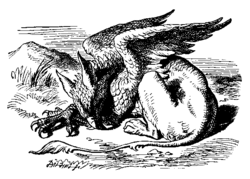
Game rules
A player may have no more than four knights, four bishops, four rooks, or two queens on the board at any one time, but may have as many as fifteen kings. Checkmating any one of the enemy kings wins the game.
Comments
"It will be seen at once that a complicacious pawn reaches the status of kingship in five moves, whereas a complicacious Rook does so in two moves. [...] Naturally, a player will not capture the enemy Queen! Neither will he desire to move his own Queen, to provide the necessary target for his opponent to win by." (Parton 1961:26)
Circular Gryphon Chess
|
Simplified Gryphon Chess
| ||||||||||||||||||||||||||||||||||||||||||||||||||||||||||||||||||||||||||||||||||||||||
Variations
In circular Gryphon Chess, players have one king for the entire game as in normal chess. But the transformation sequence is changed and made circular: pawn→knight→bishop→rook→queen→pawn. (So, a piece can transform any number of times without limitation.) Again, no more than four knights, four bishops, four rooks, or two queens are permitted in play at any one time.
In simplified Gryphon Chess, players start with their king and eight pawns. "The pawns change through the regular Gryphon order and terminate in kingship. Until a player has captured an enemy piece, he is forbidden to move his king sideways or backwards." (Parton 1974:17)
Mock Chess
| a | b | c | d | e | f | g | h | ||
| 8 |  | 8 | |||||||
| 7 | 7 | ||||||||
| 6 | 6 | ||||||||
| 5 | 5 | ||||||||
| 4 | 4 | ||||||||
| 3 | 3 | ||||||||
| 2 | 2 | ||||||||
| 1 | 1 | ||||||||
| a | b | c | d | e | f | g | h | ||
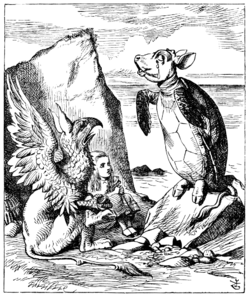
To win the game, a player must capture all his opponent's pieces, including the king. "A proper pseudomorph to Chess, for it has no elements of check and mate whatever in its basis. Kings are now merely treated like any other chessman." (Parton 1961:15)
Game rules
If a player can capture, he must do so. If more than one capture are possible on his turn, he may choose which one to make. Only one capture per turn may be made.
On its first move, a pawn must advance two squares—unless the pawn's first move is a capture.
Contramatic Chess
The normal rules for check and checkmate are contradicted—a player may not check the enemy king, but may move his own king into check. A player wins when his opponent cannot escape giving check.[lower-alpha 19]

Game rules
Players start with kings positioned as shown. White places his remaining pieces anywhere he likes on his side of the board, then Black does the same. White moves first.
Checking the opponent is not allowed. (If a player has no move other than to give check, then he loses.) A player may make a move putting his own king in check from enemy piece(s)—unless the move would also give check to the opponent. When a player is in check, his opponent must remove the check on his next turn or lose the game.
Observations
Kings tend to move more than any other piece.[lower-alpha 20] Kings cannot occupy adjacent squares, since it would result in giving check to the opponent (in violation of the rules). Captures are rare, since capturing the opponent's men reduces the chance of putting one's own king in check.
Variation
In Complete Contramatic Chess (also known as C.C.C.) each player has two kings – a normal (orthodox) king in addition to the regular "contramatic" king. There are two ways to win: putting one's own contramatic king into inescapable check, or checkmating the enemy orthodox king. Players place the orthodox kings last, after other pieces are placed.
Observations
A contramatic king can move to a square adjacent to the enemy orthodox king (since the orthodox king may be checked as in normal chess, and the contramatic king may put itself into check). But an orthodox king may not move adjacent to the enemy contramatic king (since it is not allowed to check an opponent's contramatic king, or to put one's own orthodox king into check).[12]
Idle Kings' Chess
| a | b | c | d | e | f | g | h | ||
| 8 |  | 8 | |||||||
| 7 | 7 | ||||||||
| 6 | 6 | ||||||||
| 5 | 5 | ||||||||
| 4 | 4 | ||||||||
| 3 | 3 | ||||||||
| 2 | 2 | ||||||||
| 1 | 1 | ||||||||
| a | b | c | d | e | f | g | h | ||
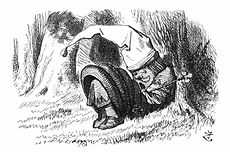
Game rules
Players play without kings until after Black's 12th move, when White places his king on any open square (but not in check), and Black does the same.
Additional rule
After kings are placed the game continues normally, except that kings may not move, unless in check.
Unirexal Chess
| a | b | c | d | e | f | g | h | ||
| 8 |  | 8 | |||||||
| 7 | 7 | ||||||||
| 6 | 6 | ||||||||
| 5 | 5 | ||||||||
| 4 | 4 | ||||||||
| 3 | 3 | ||||||||
| 2 | 2 | ||||||||
| 1 | 1 | ||||||||
| a | b | c | d | e | f | g | h | ||
Also known as The Black King's Complaint, Unirexal variants are those with only one king on the board. "The black king disappeared, explains Parton, because he was fed up with always being mated in problems."[lower-alpha 21] (Pritchard 1994:332)
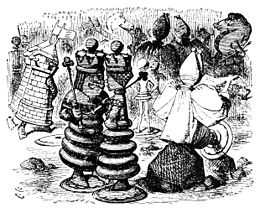
Game rules
Black has a second queen[lower-alpha 22] instead of a king, and must checkmate White in a reasonable number of moves (agreed to before the game), otherwise White wins.
| a | b | c | d | e | f | g | h | ||
| 8 |  | 8 | |||||||
| 7 | 7 | ||||||||
| 6 | 6 | ||||||||
| 5 | 5 | ||||||||
| 4 | 4 | ||||||||
| 3 | 3 | ||||||||
| 2 | 2 | ||||||||
| 1 | 1 | ||||||||
| a | b | c | d | e | f | g | h | ||
Variation
Black has twenty knights, but no king. If Black does not checkmate White within 50 moves, he loses.
Decimal Rettah Chess
| a | b | c | d | e | f | g | h | i | j | |||
| 10 | 10 | |||||||||||
| 9 | 9 | |||||||||||
| 8 | 8 | |||||||||||
| 7 | 7 | |||||||||||
| 6 | 6 | |||||||||||
| 5 | 5 | |||||||||||
| 4 | 4 | |||||||||||
| 3 | 3 | |||||||||||
| 2 | 2 | |||||||||||
| 1 | 1 | |||||||||||
| a | b | c | d | e | f | g | h | i | j |
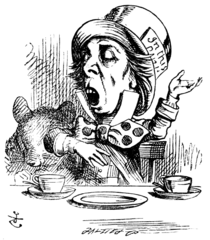
This is Parton's first chess variant invention. The idea sprang from a dislike for weak kings: "The king ought to be strong, not feeble, by aesthetic standards: he is the centre around which turns the whole game itself. In consequence, my Rettah monarch is the most powerful of all pieces." (Parton 1961:7)
Each player has two rettahs (kings) and two queens on a 10×10 board. There is no checkmate; a player wins by capturing both opponent's rettahs.
Game rules
A rettah [hatter spelled backwards] moves and captures as a Q+N compound. If a rettah is attacked, the attacking piece must be captured immediately. (If more than one piece is able to capture, the player may choose. An attacked rettah will always have the option to capture.) If a rettah is attacked by two pieces simultaneously, the attacked rettah must capture one of them (the player may choose which).
Pawns can move up to three steps on their first move. There is no en passant. If players agree, pawns can also move one step diagonally forward (to facilitate opening lines). A pawn promotes to rettah, but only if a rettah of the same colour was previously captured. There is no castling in Decimal Rettah.
Variations
Parton gives several variations, although Decimal Rettah is "possibly the earlier version and arguably the better" (Pritchard 1994:82). In Absolute Rettah Chess, only a rettah may capture a rettah. (So a successful tactic involves attacking a rettah with a piece guarded by one's own rettah.) In Giveaway Rettah, Decimal or Absolute Rettah are played according to Suicide Chess rules. In Rettah Chess (one rettah; pawns move only one step forward) and Double Rettah Chess (two rettahs; no forced capture; win by checkmating a rettah), play is on a regular 8×8 board.
Sample game
Decimal Rettah, "a game of assult and sacrifice",[15] received high praise from Boyer[6] who published the following sample game [the game uses an alternate initial setup NBKQRRQKBN and incorrect interpretation of the capture rule, requiring that only a rettah may capture its attacker]:
- 1.c3 f6 2.Qb3 Rf8 3.Qxb9+ Kxb9 4.Bf5+ Kxf5 5.e4+ Kxe4 6.f3+ Kxf3 7.Rxf3 Qc6 8.Rh3 Qxc3+ 9.Kxc3 Rc8+ 10.Kxc8 dxc8 11.Qc5 e7 12.Rxh9+ Kxh9 13.Qh5+ Kxh5 14.Ni3+ Kxi3 15.Kxi3 1–0
Identific
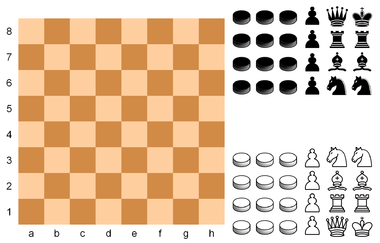
In this variant, the identity of chess pieces becomes known as play proceeds.
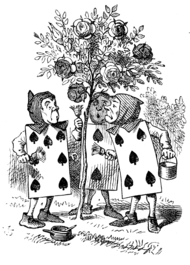
Game rules
Players first place their 12 counters (draughtsmen) on any squares of their choosing on their own half of the board. (Either White places all his counters first, followed by Black; or one per turn if the players prefer.)
After all counters have been placed, White moves any one of his counters as a regular chess piece of his choosing, then immediately replaces that counter with the corresponding chess piece. Black does similarly on his turn. These "moves of identification" obey the following rules:
- A pawn is identified by the move of a counter one step forward.
- A bishop or queen is identified by a diagonal move two or more squares.
- A rook or queen is identified by an orthogonal move two or more squares.
- Counters cannot capture or give check.
After each player has identified one chess piece, on subsequent turns players may choose to identify an additional piece from those still in-hand, or move one of their chess pieces already on the board. Chess pieces move, capture, give check/checkmate as normal, and may capture enemy counters.
A player's fourth identified piece must be his king. (Or the players can agree on a different schedule, for example, the sixth identified piece.) Players might also want to prevent the early identification of queens, for example, by requiring at least five identifications, or by limiting identification of queen to a player's last-remaining counter.
Synchronistic Chess
| a | b | c | d | e | f | g | h | ||
| 8 |  | 8 | |||||||
| 7 | 7 | ||||||||
| 6 | 6 | ||||||||
| 5 | 5 | ||||||||
| 4 | 4 | ||||||||
| 3 | 3 | ||||||||
| 2 | 2 | ||||||||
| 1 | 1 | ||||||||
| a | b | c | d | e | f | g | h | ||
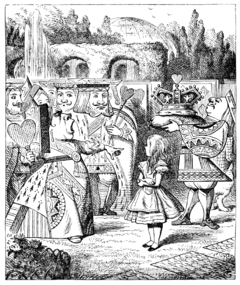
"A variant designed, part tongue-in-cheek, to achieve absolute equality." (Pritchard 1994:297) "[...] to eliminate altogether that inequality between White and Black, by the simple idea that White and Black shall always play their corresponding moves simultaneously!" (Parton 1970, Part I:9)
Game rules
For each turn players decide their moves, write them down secretly, then disclose them. They adjust the position accordingly, using the following rules of resolution when needed:
- If moves were to the same square, then White captures Black if the square is on Black's half of the board; Black captures White if the square is on White's half.
- If moves were reciprocal captures, then both pieces are removed from the board.
- If one player moved to a square the opponent's piece occupied, but that piece moved away in the turn, it is considered captured and removed from the board if it is of lower rank (K > Q > R > B > N > P). If it is the same or higher rank, then both moves stand.
In Synchronistic Chess, simultaneous checkmate is possible.[lower-alpha 24]
Damate
| a | b | c | d | e | f | g | h | i | j | |||
| 10 | 10 | |||||||||||
| 9 | 9 | |||||||||||
| 8 | 8 | |||||||||||
| 7 | 7 | |||||||||||
| 6 | 6 | |||||||||||
| 5 | 5 | |||||||||||
| 4 | 4 | |||||||||||
| 3 | 3 | |||||||||||
| 2 | 2 | |||||||||||
| 1 | 1 | |||||||||||
| a | b | c | d | e | f | g | h | i | j |
The game Damate is a synthesis between draughts and chess, ...
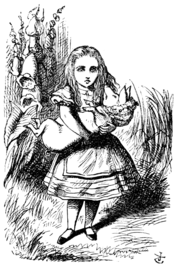
Game rules
...
List of game inventions
Chess variants
- Checkers Chess (1950s)
- Decimal Four-Handed Chess (1950s)
- Idle Kings' Chess (1950s)
- Nightrider Chess (1950s)
- Scaci Partonici (1950s)
- Decimal Rettah Chess (1952)
- Double Rettah Chess (1952)
- Rettah Chess (1952)
- Tweedle Chess (or Twin Orthodox Chess) (1952)
- Alice Chess (1953)
- Kinglet Chess (or Imperial Fiddlesticks) (1953)
- Neutral King Chess (1953)
- No-Retreat Chess (1954), co-inventor J. Boyer
- Black & White Chess (or Black & White Marseillais Chess) (1955)[lower-alpha 25]
- Degraded Chess (1958)
- Complete Contramatic Chess (1961)
- Contramatic Chess (1961)
- Damate (1961)
- Racing Kings (1961)
- Dunce's Chess (1961)
- Gryphon Chess (or Complicacious Chess) (1961)
- Jabberwocky Chess (1961)
- Knightmare Chess (1961)
- Linear Chess (1961)
- March Hare Chess (1961)[16]
- Royal Scaci Partonici (1961)
- Scacia (1961)
- Simpleton Chess (1961)
- Twin Chess (1961)
- Unirexal Chess (or The Black King's Complaint) (1961)
- Chimaera Chess (1969)
- Mock Chess (1969)
- Ambi-Chess (1970)
- Best Decimal Butter (1970)
- Blot-Straight Chess (1970)
- Butters (1970)
- Capricorn Chess (1970)
- Centaur Royal (1970)
- Cheshire Cat Chess (1970)
- Co-Regal Chess (1970)
- Cubic Chess (1970)
- Demigorgon Chess (1970)
- Dodo Chess (1970)
- Ecila (1970)
- Gorgona Chess (1970)
- Identific (1970)
- Looking-Glass Chess (1970)
- Mad Threeparty Chess (1970)
- Meddlers' Chess (1970)
- Semi-Queen Chess (or Half-Queen's Chess) (1970)
- Sphinx Chess (1970)
- Timur's Cubic Chess (1970)
- Wyvern Chess (1970)
- Circean (1971)
- Dabbabante Chess (1971)
- Decimal Oriental Chess (1971)
- Imitante Queen Chess (1971)
- Synchronistic Chess (1971)
- 2000 A.D. (1972)
- Royal Fury (1972)
- Gorgon Chess (1973)
- Megasaur Chess (1973)
- Mimotaur Chess (1973)
- Rangers Chess (1973)
- Triscacia (1974)
Draughts variants
- Damate (1961)
- Dragon
- Kinger, Simple Kinger, and Grand Kinger
- Scoundrels
Monographs (with section headings)
Curiouser and Curiouser (1961), 31 pp.
Challenge and Delight of Chessical and Decimal (1970), 14 pp.
Chesshire-Cat-Playeth Looking-Glass Chessys (1970) Part II, 13 pp.
|
Chessical Cubism or Chess in Space (1971), 16 pp.
100 Squares for Chess + Damante (1971), 16 pp.
My Game for 2000 A.D. and After (1972), 12 pp.
Idea for a Personal Game (1973), 12 pp.
Chessery for Duffer and Master (1974), 23 pp.
|
References
Notes
- ↑ "What are you three doing?" asked Alice. "We're going to have a Mad Three party" explained the Mad Hatter. Alice thought he must have meant "tea party". "Can I join you please in this party?" she asked politely, and with much curiosity over this painting with jam. "No, you can't" said the March Hare rather impolitely. "If you join, then it would be a Four party instead." Parton (1970) Part II, p. 6
- ↑ "Each player has two Kings!" replied the Hatter very crossly at Alice's ignorance in this matter. "It is home-made plain cake commonsense. One of your opponents attacks one of your kings and the other attacks the other. That is quite easy to understand. If you had only a single king it would get too complicated when both of your opponents attacked the same king." He added with a glare of annoyance at Alice's obvious doubt about that point. "If they had only one teapot they would have to halve it, and what use is half a teapot? You seem as stupid as the Dormouse!" Parton (1970) Part II, p. 7
- ↑ "When first Alice had met Dee and Dum, these two little fat men looked exactly like a couple of great schoolboys. On this occasion, however, each of them had on his head, not a school cap but an oversized king's crown! (From the Alice unwritten)" Parton (1961), p. 13
- ↑ "[...] the two Tweedle kings in the same force are exactly the same in status and in dignity; and equally have the same vital role to play during the conflict between the two colours. The checkmate of one of this player's Tweedles is at once destruction for its fellow Tweedle, as they share jointly the victory or disaster resulting from the struggle." Parton (1974), p. 9
- ↑ "[...] a player may have to face the terrible menace where check is made simultaneously on both of his monarchs by a single enemy. If he is to save his game, then this player so doubly checked must obliterate the check against each Tweedle; in which terrible situation the only saving defence is to capture that foe checking, if such escaping move happily exists." Parton (1974), p. 9
- ↑ "[...] she looked up, and there was the Cat again, sitting on a branch of a tree. 'Did you say pig, or fig?' said the Cat. 'I said pig,' replied Alice; 'and I wish you wouldn't keep appearing and vanishing so suddenly: you make one quite giddy.' 'All right,' said the Cat; and this time it vanished quite slowly, beginning with the end of the tail, and ending with the grin, which remained some time after the rest of it had gone." Alice's Adventures in Wonderland (Chapter 6), "Pig and Pepper"
- ↑ "In a real Alician Tale, I would obviously invite the Carpenter with the Walrus to help him if needed, to saw such a square out of a wooden chessboard." Parton (1970) Part II, p. 1
- ↑ "The essential feature of this Alician theme is that, as a co-regal piece, a Queen will now become fully subject to all rules relating to check and checkmate exactly as is her King. No longer will her Majesty the Queen suffer that indignity of being roughly captured by some inferior enemy piece, and then thrown most ungracefully for any lady, into the chessbox like a common Bishop!" Parton (1970) Part I, p. 2
- ↑ "An early blow struck on behalf of sexual equality." (Pritchard 1994:72)
- ↑ kNights Of the Square Table (NOST), a (now defunct) correspondence game club formed in 1960 by Bob Lauzon and Jim France, enjoyed several hundred active members (Pritchard 1994:210).
- ↑ "The peculiarity of Dodo Chess is that the purpose of play is a sort of racing competition between the Kings (such an idea was naturally expected of the Dodo)." Parton (1970) Part I, p. 12
- ↑ "'What I was going to say,' said the Dodo in an offended tone, 'was, that the best thing to get us dry would be a Caucus-race.' 'What is a Caucus-race?' said Alice; not that she wanted much to know, but the Dodo had paused as if it thought that somebody ought to speak, and no one else seemed inclined to say anything. 'Why,' said the Dodo, 'the best way to explain it is to do it.'" Alice's Adventures in Wonderland (Chapter 3), "A Caucus-Race and a Long Tale"
- ↑ "That quite extinct bird was on this occasion explaining to the White and Red Kings how they ought to play chess according to its rules. The Dodo earnestly and with many tears begged Alice to write down these special rules in her memorandum book, in order that the game of Dodo Chess, quite unlike the poor bird itself should never, never, never at all become extinct." Parton (1970) Part I, p. 12
- ↑ "The starting position and the fact that there are no pawns marks it further as a game out of the ordinary. [...] it is one of the more inspired creations of Vernon Parton, a prolific inventor of odd games." (Pritchard 2000:14)
- ↑ Or, Parton suggests the players' back row of pieces may be randomized for an equally playable startup (Pritchard 1994:159).
- ↑ "Kings retain their ordinary move, of course, but they are now humiliated as it were, by being treated on the same level as the rest of the chessmen. In this game a King can suffer the indignity of being captured and lifted off the board and dropped into the chessbox, just as the White King was unceremoniously lifted up by Alice in her story." Parton (1961), p. 4
- ↑ "For some time the Looking-glass was stubborn in its refusal to permit the Red Queen to pass through. At last, when the White Knight arrived and began to suggest that he might charge through on his Horse with all their heavy armour, then the Looking-glass agreed, but reluctantly, to allow them to pass through itself. Nevertheless, the condition which the Looking-glass claimed on return was that Alice should write down there and then in her [memorandum] book, how the Looking-glass saw the game of Chess, both 'inside and outside' of course! For playing the 'Looking-glass Game', two chessboards and two ordinary sets of chessmen are required. The two boards are placed side by side, and between them is to be imagined the Looking-glass itself!" Parton (1970) Part II, p. 3
- ↑ "An ordinary piece must have a very dull existence for it is always the same thing. Now look at me, am I not two things all at the same time?" Alice, looking at the Gryphon with its eagle's head and wings, but with its lion's body, thought to herself: "It isn't really two things at the same time, but only parts of these two things." She saw a grin slowly spreading about the creatures beak as a thought spread through its mind. Then it chuckled and said, half to itself and half to Alice: "What un-fun!" "What is the un-fun?" asked Alice with curiosity. "Ordinary pieces," replied the Gryphon. "It's all their un-fancy, of course; they hasn't got no metamorphosis. Indeed, the plain unvarnished truth of this fancy is that the pieces does change, and they does be complicacious." It repeated the word "complicacious" as if it found this word a tasty morsel to have in its beak. Parton (1961), "Gryphon's Fancy and Fun", p. 26
- ↑ "As the character of my 'Blue Caterpillar' idea is truly the logical contrary of orthodox checkmate, my name of 'Contramatic' is obviously the right name to give this Antipodean idea." Parton (1961), p. 22
- ↑ "The player usually thinks of the King as what is 'hunted or chased.' Whereas formerly the enemy pieces attacked the miserable monarch, here now he is attacking and chasing them instead. Very probably, the most 'chased and hunted' by this special King will be the hostile Queen." Parton (1961), p. 23
- ↑ "Alice heard someone weeping behind the chessbox, and there she found the Black King shedding bitter tears into a bucket. 'What is the trouble, Your Majesty?' asked Alice with sympathy. 'They are most unkind. Why am I always the one chosen to be checkmated in problems? They are not fair to my royal dignity. It is really time that old White King took his turn. [...] I know now what I must do. I will disappear; then they will really have to find something else to checkmate.' Alice saw the Black King thereupon change himself completely into hot tears and splash into the bucket, where he boiled rapidly away from sight! (From the Alice unwritten)" Parton (1961), p. 11
- ↑ A rook, bishop, knight, or even pawn may replace the black king instead, if the players prefer (Parton 1961:11).
- ↑ Parton expressed no preference for a particular back rank setup. Another is RNKBQQBKNR given in Feenschach.
- ↑ "Most non-taking moves, and takes where the pieces captured did not move, will scarcely raise a difficulty. Whatever the fantastications created, my idea Synchronistic is the most just and rational form of Chess! Indeed, in the Synchronistic game, it is possible for the white and black Kings to be checkmated simultaneously! What can be more equal?" Parton (1970) Part I, p. 10
- ↑ Credited to Parton and published in the March 1955 issue of British Chess Magazine (Pritchard 2007:23).
Citations
- ↑ Pritchard (1994), p. 3
- ↑ 2.0 2.1 Pritchard (2000), p. 68
- ↑ 3.0 3.1 Parton, Peter (Winter 2001)
- ↑ Pritchard (1994), p. 77
- ↑ Parton (1961), p. 9
- ↑ 6.0 6.1 Boyer, Joseph (1954). Nouveaux Jeux d'Echecs Non-orthodoxes. Paris.
- ↑ Parton (1970) Part II, p. 2
- ↑ Pritchard (1994), p. 72
- ↑ 9.0 9.1 Pritchard (1994), p. 247
- ↑ Pritchard (2000), p. 15
- ↑ Pritchard (1994), p. 159
- ↑ Parton (1961), p. 31
- ↑ Through the Looking-Glass, and What Alice Found There/Chapter I
- ↑ Nixon, Dennison, ed. (December 1952). "[unidentified title]". Fairy Chess Review.
- ↑ Pritchard (1994), p. 82
- ↑ Pritchard (2007), p. 62
Bibliography
- Parton, Peter (Winter 2001). "Reflections on Vernon Rylands Parton". Abstract Games (Carpe Diem Publishing) (8): 9. ISSN 1492-0492.
- Parton, V. R. (1961). Curiouser and Curiouser.
- Parton, V. R. (1970). Chesshire-Cat-Playeth Looking-Glass Chessys. Part I.
- Parton, V. R. (1970). Chesshire-Cat-Playeth Looking-Glass Chessys. Part II.
- Parton, V. R. (1974). Chessery for Duffer and Master.
- Pritchard, D. B. (1994). The Encyclopedia of Chess Variants. Games & Puzzles Publications. ISBN 0-9524142-0-1.
- Pritchard, D. B. (2000). Popular Chess Variants. B.T. Batsford Ltd, London. ISBN 0-7134-8578-7.
- Pritchard, D. B. (2007). Beasley, John, ed. The Classified Encyclopedia of Chess Variants. John Beasley. ISBN 978-0-9555168-0-1.
- Schmittberger, R. Wayne (1992). New Rules for Classic Games. John Wiley & Sons Inc. ISBN 978-0471536215.
External links
- Vernon Rylands Parton (1897–1974) by Jean-Louis Cazaux, The Chess Variant Pages
Games
- Alice Chess by Edward Jackman and Fergus Duniho, The Chess Variant Pages
- Cheshire Cat Chess by Hans Bodlaender, The Chess Variant Pages
- Kinglet by Hans Bodlaender, The Chess Variant Pages
- Kinglet by Uwe Wiedemann, Zillions of Games
- Racing Kings and Dodo Chess by Hans Bodlaender, The Chess Variant Pages
- Racing Kings play Racing Kings online at BrainKing.com
- Rettah by Vu Q. Vo., The Chess Variant Pages
- Unirexal Chess by Hans Bodlaender, The Chess Variant Pages
Simple programs by Ed Friedlander
- Alice Chess Pathguy.com (Java)
- Cheshire Cat Chess Pathguy.com (Java)
- Contramatic Chess Pathguy.com (Java)
- Co-Regal Chess Pathguy.com (Java)
- Dodo Chess Pathguy.com (Java)
- Gryphon Chess Pathguy.com (Java)
- Identific Pathguy.com (Java)
- Idle Kings' Chess Pathguy.com (Java)
- Kinglet Chess Pathguy.com (Java)
- Mad Threeparty Chess Pathguy.com (Java)
- March Hare Chess Pathguy.com (Java)
- Mock Chess Pathguy.com (Java)
- Racing Kings Pathguy.com (Java)
- Rettah Chess Pathguy.com (Java)
- Simplified Gryphon Chess Pathguy.com (Java)
- Twin Orthodox (Tweedle) Chess Pathguy.com (Java)
- Unirexal Chess Pathguy.com (Java)
|